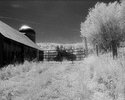My conclusion so far, based on various responses, is that this Adox film may not be different enough from Rollei Retro 80s to make much of a difference for the user so price might well be the deciding factor and yet both Rudeofus and Bill Burk have given us ( well me at least) quite technical responses which might suggest otherwise.
I have no experience with Rollei Retro 80s nor with this new Adox film, but my impression is that the Rollei product is straight Agfa Aviphot Pan 80, whereas for the Adox product they preflash the film before packaging. If I read these
two reviews, the motivation for preflashing appears clear: in its original form Pan 80 has a sharp toe and high contrast, and therefore won't handle underexposure gracefully. The author of the review PDF still recommends it at EI160 with HC-110, a developer not exactly known for giving films high speed.
The Adox product is preflashed, which does a few things:
- It gives some base fog. If you want to create B&W slides, get the Rollei, or get Silvermax if you want an Adox product.
- The toe becomes rounder, which in turn means two things: you can get discernible shadow detail at lower light levels, but in regions where the 80s already has normal contrast the Adox film will still have low contrast.
- If you push develop the Adox film, you can boost toe contrast to normal levels, but midtone and highlight contrast will also go way up (see page 4 on Agfa's Aviphot Pan 80 data sheet).
One thing which I would like to find out at some point: are all these new films based on some Aviphot product made from fresh master rolls coated specifically for these products, or are these cut from old, frozen master rolls? This may be irrelevant for these film's properties right now, but may give us some indication about how long these products will be around in future.






